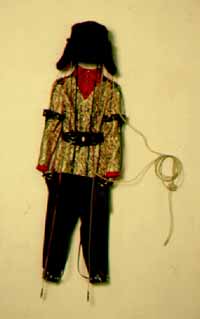
Rosalind Brodsky'sElectronic Time Travelling Costume to go to the Russian Revolution
In 2017 Brodsky celebrated the centenary of the Russian Revolution by travelling to Moscow in the year 1917.
On the morning of October 25th she was assigned a position, under Bubnov, helping to look after postal and telegraphic and railway communications. During the afternoon Brodsky managed to send herself a postcard home.
Brodsky voiceover from cd rom:
"Hi there, this is my electronic time travelling costume I first made in order to visit the Russian Revolution. In 2017 the Institute sent all its employees there for a centenial celebration...I made a film based on a fictional account of the event...check out my file for info on it. What in reality happened was somewhat different.On my first attempt I ended up on the set of Dr Zhivago in 1965. It was great meeting Omar Sharif and we went to some amazing bars.
Other times I ended up in remote parts of Russia but finally I made it and joined a column of Bolsheviks marching through the streets. I got taken away because my costume just didn’t fit in and someone sent me off to look after postal and telegraphic communications under Bubnov. While I was there I sent myself some postcards home...only one of them arrived.
To operate the costume I just flick the switch on my belt. Attached to my arms are prayer boxes but they don’t always work. All the wires connect up to equipment in my attaché case which I have to pre-program before I leave, with departure and return times too. It gets to be pretty annoying sometimes when I have to disappear midway through a conversation. On one trip I hung around for hours until I eventually met Lenin and just when he was telling me about his favourite food the beeper went and I got transported back to the Institute."
In 1994 Rosalind Brodsky made a film, semi-autobiographical, about an incident at the Institute.In 2017 the Institute celebrated the centenary of the Russian Revolution by sending all of its employees, including Brodsky, to a virtual simulation of Moscow in the year 1917.
Due to overloading of the equipment there is a technological dysfunction and Brodsky's body rematerialises in the year 1995. Her body, aged forty seven, walks around in a seemingly trance-like state, passing easily through cars, people and architecture within a certain area of London.
Brodsky is unaware of being in London as her eyes are reading digital information which tells her she is moving around a simulation of Moscow in the year 1917.
This drifting body is inevitably sighted and photographed by journalists and members of the public, one of whom turns out to be Rosalind Brodsky aged twenty five. Brodsky stalks this/her own body and maps the paths taken, noting abrupt turns, the mounting and descending of stairs where there are none, the places of interaction with invisible others, the 'opening' of doors, the boundaries of the area traversed.
Brodsky is in no doubt that there is a parallel space being negotiated. She constructs a map of this parallel space and after much research identifies it as the space within the Kremlin at the time of the Russian Revolution.
Brodsky has since made works , related in part, to ideas brought up by the film.